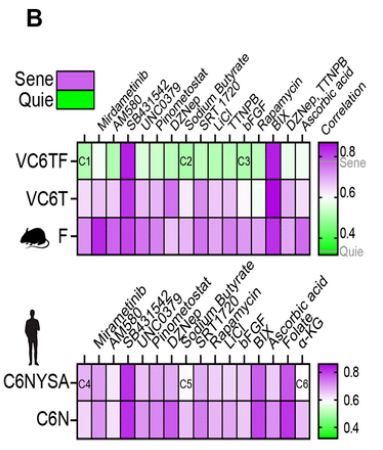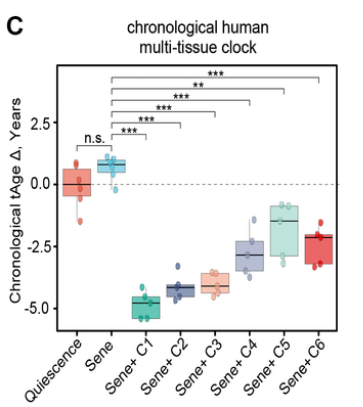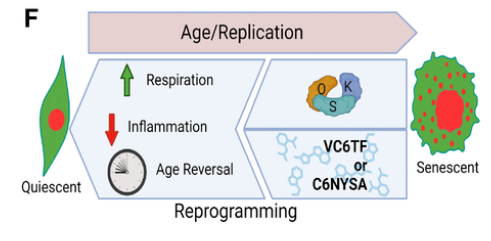Dr. David Sinclair shared the news of an exciting breakthrough in age-reversal research on Twitter, stating –

A team of scientists from Harvard Medical School discovered a method to distinguish young cells from old and senescent cells in real time. This allowed them to quickly screen the effect of different molecules on cellular health.
Using this method, they were able to identify 6 different combinations of molecules that can be used to “reset” the age of cells to a youthful, healthy state.
These “chemical cocktails” may replicate the effects of the Yamanaka factors which are being used in laboratories to reset cellular aging.
Highlights:
- Developed method to quickly screen small molecules ability to rejuvenate old cells
- Tested 80 existing cocktails of small molecules using their method
- Determined 6 combinations were effective
- Three combinations reduced the measured age by more than three years after only four days of treatment
According to the lead scientist, Dr. David Sinclair:
“Now we show it’s possible with chemical cocktails, a step towards affordable whole-body rejuvenation”
“This new discovery offers the potential to reverse aging with a single pill, with applications ranging from improving eyesight to effectively treating age-related diseases”
Study Details
In this study, researchers created advanced tests using human cells to identify substances that can reverse the aging process and revitalize cells without making changes to their genetic material.
These tests, known as high-throughput cell-based assays, were designed to differentiate between young, old, and senescent cells. The tests involved the use of transcription-based aging clocks, and a real-time nucleocytoplasmic compartmentalization (NCC) assay.
Their aim was to identify small molecules to reverse the effects of aging and senescence. Six chemical cocktails were identified in less than a week.
The six chemical cocktails had a significant impact on cells, reversing their transcriptomic age, which means the cells became similar to that of younger ones. Additionally, there was a reversal in their genome-wide transcript profile, indicating that their gene expression patterns associated with cellular aging were reversed.
Nucleocytoplasmic Compartmentalization (NCC)
Researchers focused on identifying molecules which could reverse epigenetic aging by targeting nucleocytoplasmic compartmentalization.
“One of the most well-conserved physiological hallmarks of aging is deterioration of nucleocytoplasmic compartmentalization (NCC), which can be visualized as the leakage of nuclear proteins into the cytoplasm and failure of proteins to be imported into the nucleus [34, 35].”
As organisms age, there is a tendency for nuclear proteins to leak or migrate into the cytoplasm instead of staying confined within the nucleus. These disruptions in NCC are considered to be widely observed phenomena associated with aging.
The NCC reporter system was used to identify molecules that can reverse epigenetic aging by targeting nucleocytoplasmic compartmentalization. The NCC system was able to distinguish between senescent and non-senescent cells, in real time.
Reversal of Characteristics of Cellular Senescence by Epigenetic Reprogramming
Here they investigated if the observed phenotypic changes in cells were reflected in a more youthful epigenetic signature.
They induced the expression of the Yamanaka Factors: OSK (OCT4, SOX2, and KLF4) for four days, which resulted in reduced expression of 43.2% of age-upregulated genes and increased expression of 65.3% of age-downregulated genes.
Approximately half of the genes that were changed due to senescence were restored by the expression of OSK.
- This finding is consistent with previous studies that have shown the ability of OSK to restore the gene expression patterns of old cells.
The process of using OSK to reverse the age-related changes in cells is referred to as the EPOCH method, which stands for epigenetic programming of old cell health.
Transition from Quiescence to Senescence
Using the NCC system, they examined the deterioration of nucleocytoplasmic integrity as cells transitioned from quiescence to senescence and the rejuvenative effects of OSK treatment on those senescent cells.
- After four days of OSK treatment, NCC integrity was significantly restored in senescent cells, comparable to the quiescent, non-senescent cell population.
“Taken together, these data show that OSK-mediated epigenetic reprogramming substantially reverses senescence-associated pathology and transcriptomic changes and that the NCC reporter system can detect rejuvenation of senescent cells by OSK.”
Small Molecules to Rejuvenate Old and Senescent Cells
To identify small molecules that rejuvenate old and senescent cells, they curated a list of molecules that have successfully reprogrammed human and mouse somatic cells into chemically induced pluripotent stem cells (CiPSCs) and tested them using the NCC assay.

Among 80 cocktails tested in the NCC assay, the VC6TF basal cocktail was the most effective at restoring the integrity of nucleocytoplasmic compartmentalization, a key sign of age-reversal.
Next, they chose 6 cocktails of small molecules for further investigation.
The six cocktail combinations are listed in this document.
- Sodium butyrate, a histone deacetylase inhibitor, was one of the most effective additives in both human and mouse cocktails (C2 and C5).
- Basic fibroblast growth factor (bFGF) was used for Cocktail 3, while α-KG was included in Cocktail 6.
Partial Reprogramming without a Full Reset to Pluripotency
After applying the chemical treatments, there was a significant similarity in the genes that were affected by the chemicals and the genetic changes associated with the transition from quiescence (cellular dormancy) to senescence (permanent growth arrest).
“Collectively, these data indicate that chemical-mediated treatments are only partially reprogrammed and not fully reset to pluripotency.”
Transcriptomic Age Tested with Clocks
They then tested six cocktails on the transcriptomic age (tAge) of the cells using clocks trained on mouse, human, and a combined training data set. The change in years of age was determined using a human-specific chronological clock.
“All six reprogramming cocktails also significantly decreased the estimated chronological age of NCC senescent cells by several years.”

Treatment of NCC cells with each of the six chemical cocktails (C1-6) resulted in statistically significant reduction of the transcriptomic age of senescent cells, with those originating from mouse studies (C1-3) generally producing a greater decrease in transcriptional age relative to the human derived cocktails
“Furthermore, the observation from the transcriptomic clocks that all six chemical cocktails, C1-C6, decreased both biological and chronological age below that of even the non-senescent cell populations, indicates that the cocktails are potent and capable of reversing senescence-associated cellular dysfunction.”
Gene Set Enrichment Analysis (GSEA) Performed
This was done to identify which pathways might be responsible for the similarities and differences between the chemical treatments, signatures of aging, and OSK(M)-induced iPSCs.
“Together, these data show that the chemical cocktails identified in this study not only reverse the effects of senescence on NCC and make them transcriptionally younger, but they also reverse key transcriptional signatures of senescence.”

The graphic represents their research findings which demonstrates that both activating OSK and using C1-6 chemical cocktail treatment have the ability to repair NCC integrity, adjust transcript profiles, and reverse health-related biomarkers.
Conclusion
The study demonstrated the profound effect of the chemical cocktails, leading to:
- a reversal in the age-related changes in the overall gene activity patterns of the cells, known as the genome-wide transcript profile
- a reversal in the transcriptomic age, indicating that the gene expression profile of the cells became more similar to that of younger cells
Additional studies are currently being conducted to understand the cellular processes and mechanisms responsible for the rejuvenating effects observed in previous research. Specifically, these follow-up studies aim to investigate how cells are able to “write” and “read” a “backup copy” of earlier epigenetic information.
“The observation that genetic and chemical rejuvenation of cells is possible, restoring earlier gene expression patterns while retaining cellular identity, indicates that old cells possess information to reset their biological age, consistent with the Information Theory of Aging. Identifying how this putative information is encoded and where it resides will greatly speed the development of increasingly effective approaches to rejuvenate cells.”
